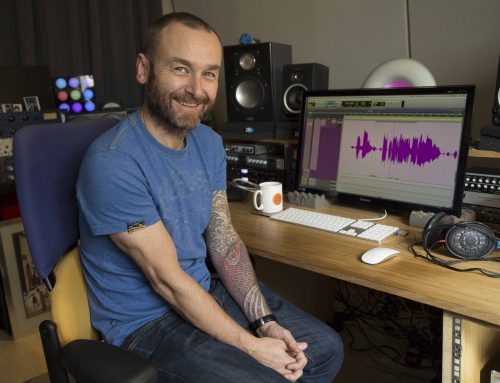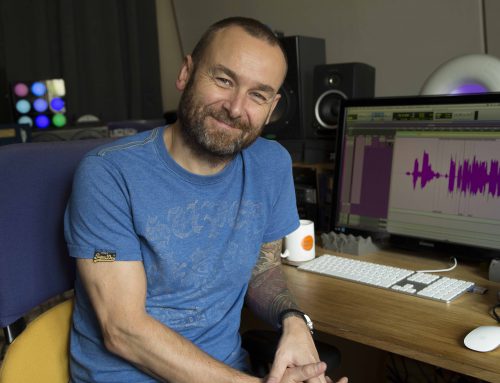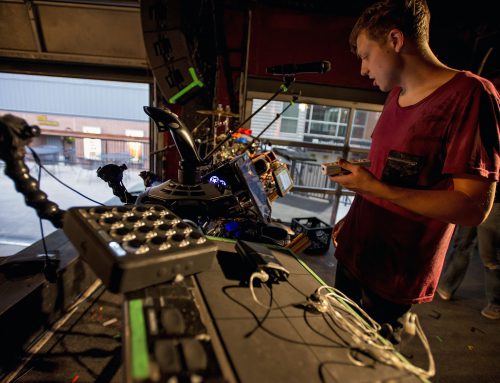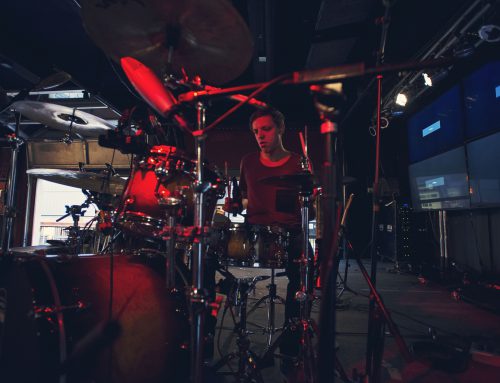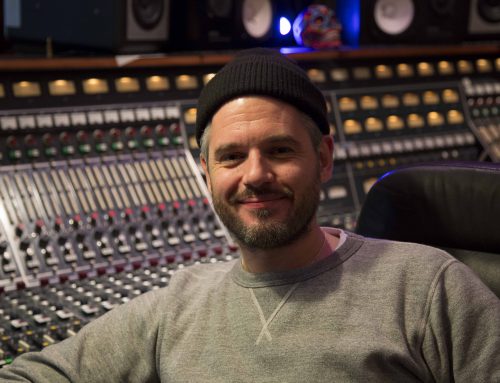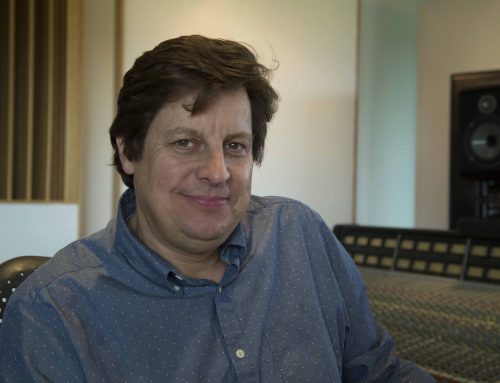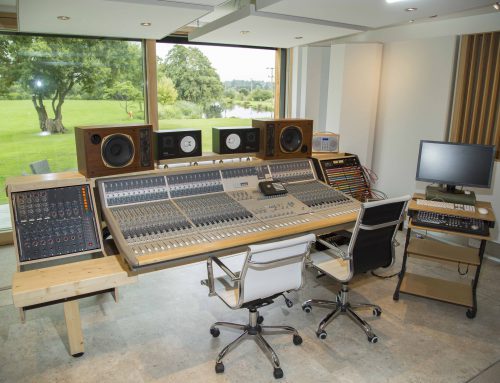In this, the second part of our interview with Mark, he talks about recording and mixing hip hop and crunk, revealing what kind of software and hardware he likes to use, and why.
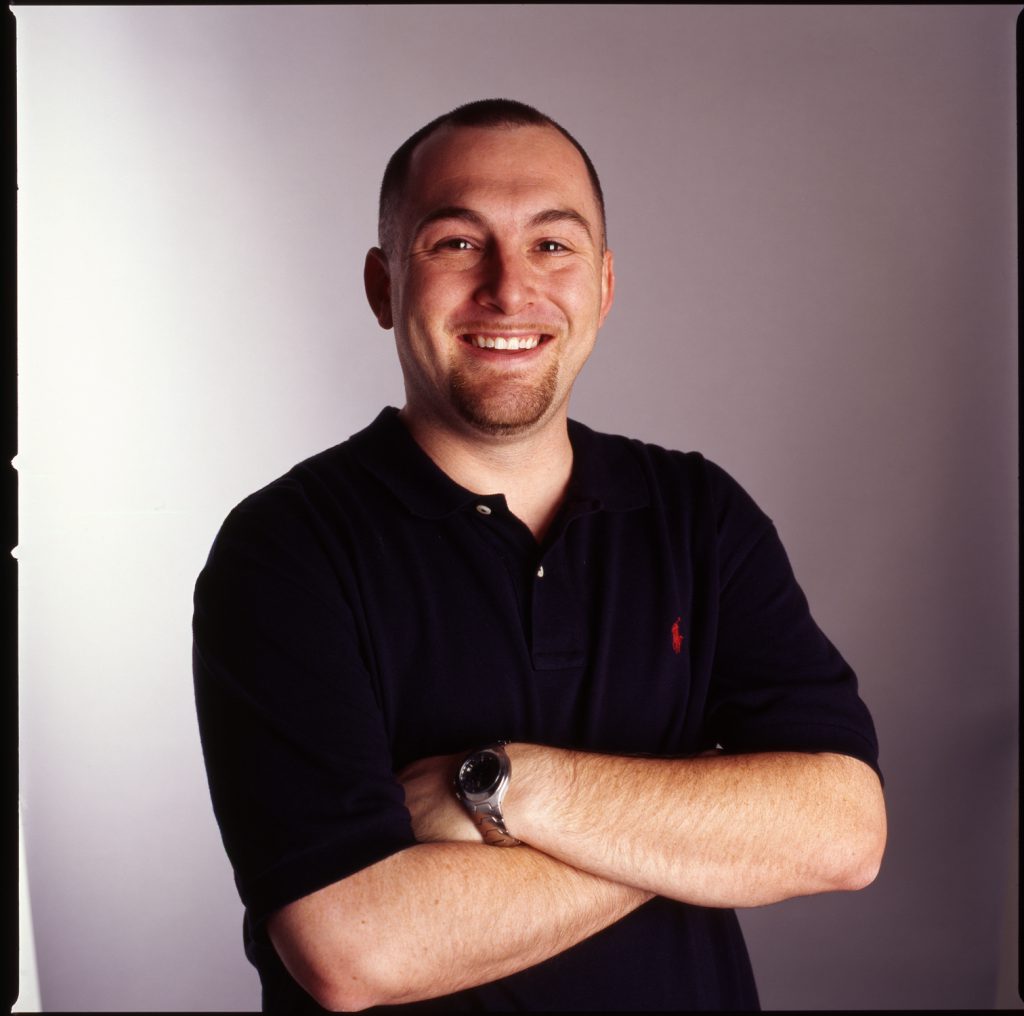
A publicity shot of Mark
Part 2: Mixing and Recording Methodologies
There is no denying that hip hop and crunk are very modern styles of music in the general scheme of things, but Mark’s methods sound surprisingly traditional in many ways.
“I don’t start by looking at the technical aspects of a mix,” he insists. “The important thing, which I try to look for when I’m starting a mix, is the actual feeling of the song. It is very important for me to listen to the rough mixes of any song I’m doing because so many people hear the rough mix and fall in love with it. If you then change the mix going forward they are not going to like it, whether it is better or worse than the rough version.
“Technically speaking, I make sure everything is turned down first in Pro Tools, and then I start with the vocals, so all the musical elements and effects will be off. If it wasn’t something I did then the first thing I do to the vocal is make sure all the edits are clean. I listen for any mistakes or small editing things that need to be fixed, and when everything is clean and sounds good to mix vocally, I start processing the vocals and finding the compression, EQ, delays, reverbs – things that I think are going to match the song – and getting a blend of all the vocals together to see if, vocally speaking, I’m in the right place.
“The one reason I save the music for last is because the lead vocal is the most important thing for any song. Whether it is barely in the song or all over the song, the vocal is what people listen for, so, in principle, I think there is no reason not to start with that and make sure it’s right first while your ears are still healthy and haven’t been worn out by working for hours and hours.
“I have a certain approach to compression, where less is more. I really don’t like compression all that much, so I guess my approach is just to make sure the vocal is smooth and that certain peaks aren’t going too far beyond the volume range of the track.
“Akon’s vocal, for example, is very dynamic, but I try to keep it that way. I don’t like to see my compressor needle move very much unless he’s yelling or doing something that’s just very obnoxiously loud. When I am recording I like to capture that image as it is and then, later, if the mix calls for compression, I use it. But I think it is better to keep things how they were intended and performed and let the mix dictate how it’s supposed to sound. And I don’t use compression too much as an effect unless it is really necessary on certain things.
“I guess with my vocal chain what you normally see is a Neumann U87 – which you can never go wrong with – or Sony C800G microphone, and then a John Hardy M1 Mic Pre, and then a Tube Tech C01B compressor.”
Mark is also fairly conservative when it comes to using EQ, preferring to cut rather than boost, in most situations.
“The only time you see me using a boost EQ is from 8000KHz up,” he insists. “Everything else is being cut. The boost above 8000KHz is just to add presence and bring out the high end, because even if you record the vocal as best as you can, it’s still not going to capture that right-in-your-ear sound. EQ will help with that but for everything else I’ve found that cutting is much better than boosting.
“If you are adding things then you don’t want to add much. I don’t cut or boost more than 3 or 4dB. If I am doing more than that then I feel that I have a problem and need to find a different approach to how I am processing.”
Hip hop mixes tend to be rather minimal, sometimes comprising nothing more than a vocal, some beats, and the odd bass riff. One of the challenges Mark faces in his work is treating just a few elements so that they come together as a mix and still have impact. Mark describes his philosophy.
“I work on a lot of independent hip hop where it is extremely basic and there is not much to work with. I find that in those instances, everything should be loud and pretty equal in the mix. I try not to think about it very much because my philosophy as a mix engineer is that I am not supposed to produce the song because that has been done already. There are mix engineers who are going to produce your record and they might add things to it and maybe layer your sounds and even add an element to your song, but for me, personally, I don’t believe that that is what I am paid to do as an engineer, unless I am specifically asked.
“I actually find my best mixes are the ones where I use very little EQ and processing and just balance it. I’ve had my most happy clients saying that the mix sounds amazing when I’m using something like 20 plug-ins on a 24-channel Pro Tools mix. That proves to me that they already know how they want things to sound, which is why I don’t add to songs.”
“So if I am given a mix that is minimal I am going to return a mix that is the very best I can where you hear everything as clearly as possible and as loud as necessary, but without any added sounds. Maybe I’ll add vocal effects and reverb on snares or hi-hats to, hopefully, give a little more dimension to the sounds, but no actual production elements.”
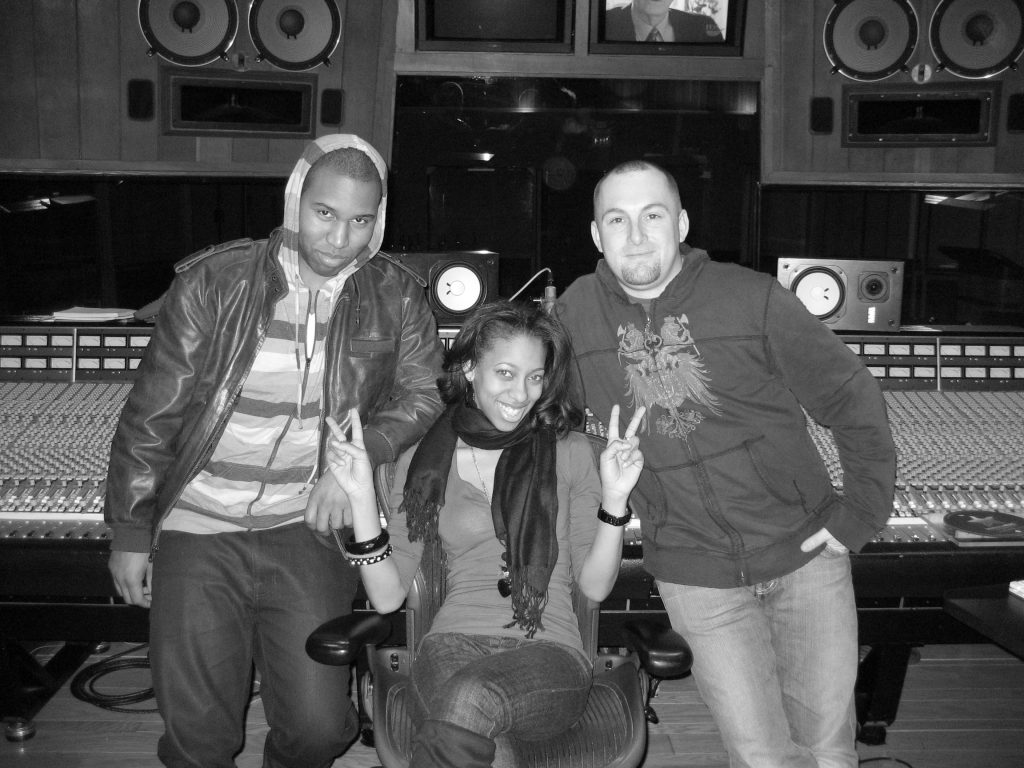
Exit with songwriter Claude Kelly and Universal/Motown recording artist Suai at Henson in LA
Software is King
When it comes to processing, Mark doesn’t venture outside the software environment very much, preferring the convenience of a portable computer-based system which has total recall and requires a minimum of power inputs and leads.
“For song production, rather than mixing,” says Mark, “I use Logic Audio, a phantom keyboard and various Emu rack modules like the Proteus 2000 and the Mo’Phatt sound modules. They have been out quite a while and have become a staple part of the Akon sound, so we rent them at every studio we go to. But when it comes to mixing, I keep song mixes completely within Pro Tools. With every client I have these days, not just Akon, we work on so many songs that it’s not convenient to split songs down onto a console.
“When I was mixing on SSL consoles I used the BBE Sonic Maximiser a little bit but now that I keep things in Logic and Pro Tools I am exploring what I can and can’t do with equivalent plug-ins. Very rarely do I feel I need to find an analogue piece to add anything. I think that all products, whether they are analogue or digital, are tools, and when you are given a set of tools it is up to you to make them work the way you hear in your head, so I try to limit myself to the ones I have digitally. That is especially important for me because I move around so much. In the last two months I’ve been home for maybe a week and-a-half. Sometimes I’m flying to London to work for one day, which is a day of travelling for just a day of working.
“The plug-ins which I make sure are always part of the system are pretty standard. There’s the Waves Platinum bundle which includes the Renaissance package. I use it a lot. Then there are things like Antares Autotune and Synchro Arts VocALign, and I have my own authorization code for the Waves 4000 SSL plug-in bundle and insist that it is loaded up everywhere I go. I also like the Renaissance EQs and the Renaissance Bass enhancer, although I use that very sparingly. I think people can push it too hard on sessions and start destroying sounds with it.”
A common criticism of modern pop productions is that they tend to suffer from over-compression, where the dynamic range of the music has been reduced to just a few dB for the sake of having every section of the track appear loud. The challenge for the mix engineer is to take dynamically limited tracks and somehow create the illusion that they get louder during choruses and other key moments. Mark explains a few of the tricks he has learnt.
“I use a lot of automation to bring things down in certain places and put emphasis on other parts. In a chorus, for example, a lot of things can get drowned out because there is so much happening when vocals and other musical elements come in, so I may automate the hi-hat and percussion to accent the rhythm of the song. I find myself turning percussion up a lot in choruses, bridges and at the end of songs.
“I also automate strings a lot. They are something you can have a lot of fun with using automation. I think strings are very important because when they are loud they have a very serious effect, but when they are low, they become what I like to call ‘headphone candy’. It is something you might not notice in your car, but when you are listening much more closely on earphones you hear the detail in a different way and grow to appreciate it. So I do a lot of automation on strings to make sure they are always there. Sometimes you might not hear much of them, whereas other times they are there in your face.”
Working with Akon
For the time being, Mark is happy to be Akon’s first-choice engineer, not only because it has enabled him to travel the world and get paid to do so, but also because the pair have developed a satisfying working relationship. Mark explains how the understanding has developed.
“I think I’m a strong part of Akon’s writing process because I know what he wants and so I enable him to move at the speed he wants to move. If Akon leaves me in the studio working with a songwriter he’s collaborating with, I am able to dictate to the songwriter what I know Akon will ask for.
“I know he’s going to want me to use Synchro Arts VocALign on certain backgrounds, for example. And he always wants a certain reverb and certain delay, so I always have them prepared for him. He always wants a quarter-note delay and a nice reverb so I use the basic Waves Renaissance RVerb, and then the DigiRack delay plug-in for the delays. If you listen to any of Akon records from the last couple of years you’ll hear a lot of quarter note delays throws – it’s a very big part of his sound.
“We always have the delay running – we call it a ghost delay – behind the vocal, just to give the sound more excitement, but then he’ll want the emphasis to be on certain words at the end of lines, so I’ll start automating the delay on those words. On the Michael Jackson song, for example, he sings, ‘I met her on a walkway’, and you hear ‘walkway’ repeat.
“We do it all throughout his songs; on choruses, backgrounds, bridges, lead vocal; everything. He always wants reverb and delay, so if we’re recording and he has to go out the booth and take a phone call, before he’s done with the call I’ve added the delays and automated them on certain words, because I know he’s going to ask for it. I don’t try to anticipate everything, but normally I know. So I think the fact that I know how to do it quickly makes him demand I work with him wherever he goes.” TF
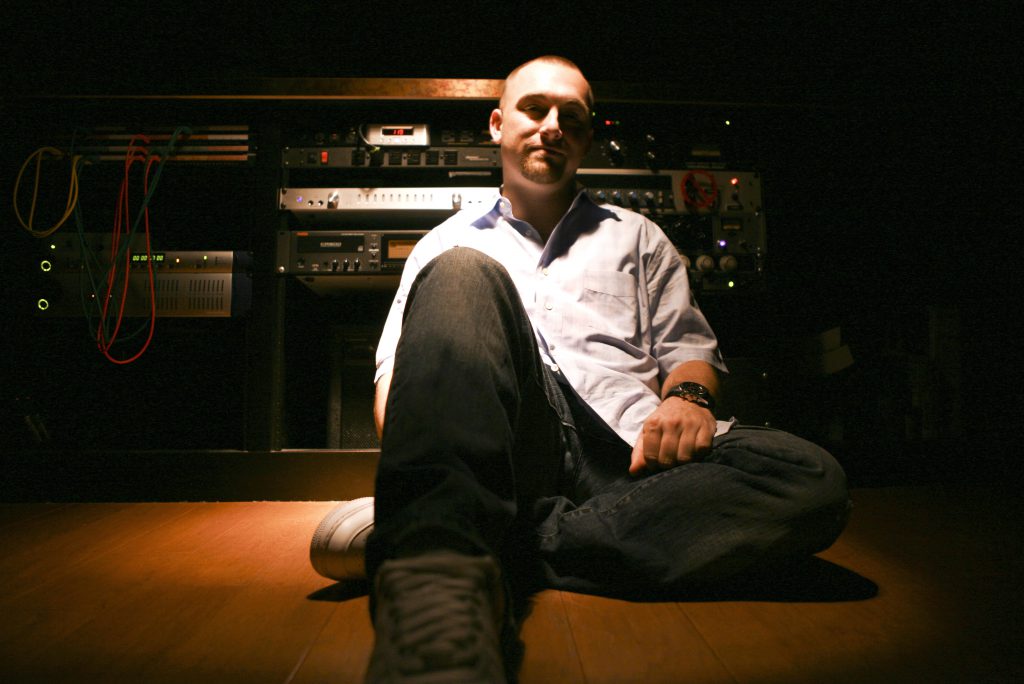
After the band has gone home…
Exit Strategy
“The Exit part of my name comes from DJ Exit. At high school I was called DJ Mischief, which was a horrible DJ name. But I liked a girl who lived in a different part of the state and I knew was she lived off of Exit 6. Every time we would go there I would say ‘We need to get off at this exit,’ and it just became something. I was so in love with this girl that when I was doodling in my Drivers Education class I wrote Exit 6 all over everything and came up with DJ Exit 6, which sounded cool. Then I just I took the 6 off. One night I was at a college party where there was a New York DJ spinning. I told him my name was DJ Exit and he said ‘That’s hot,’ so I was like, ‘Yes! I have a DJ name!’ When I started interning at DARP studios everybody knew me as DJ Exit, so the name stuck. I still DJ here and there for free.”
Part 1 of Mark ‘Exit’ Goodchild: On the Road with Akon, can be found here: Part 1

